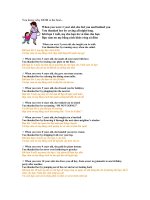You cant teach until everyone is listening
Bạn đang xem bản rút gọn của tài liệu. Xem và tải ngay bản đầy đủ của tài liệu tại đây (1.63 MB, 169 trang )
FM-Page-45574:FM-Page-45574.qxd
4/11/2008
4:14 PM
Page i
FM-Page-45574:FM-Page-45574.qxd
4/11/2008
4:14 PM
Page ii
To Alia, with her brilliant personality, playfulness, and humor,
who came into my life unexpectedly and enhances it immeasurably;
to her friend Ocean who is as beautiful in every way as her name;
and to twins Violet and Aria, miracles who make every day a joy and
who take my breath away; Alia, Ocean, Violet, and
Aria, the future is yours.
Source: Photo, art, and production by Dave and Jen Page.
FM-Page-45574:FM-Page-45574.qxd
4/11/2008
4:14 PM
Page iii
FM-Page-45574:FM-Page-45574.qxd
4/11/2008
4:14 PM
Page iv
Copyright © 2008 by Corwin Press
All rights reserved. When forms and sample documents are included, their use is
authorized only by educators, local school sites, and/or noncommercial or
nonprofit entities that have purchased the book. Except for that usage, no part of
this book may be reproduced or utilized in any form or by any means, electronic
or mechanical, including photocopying, recording, or by any information storage
and retrieval system, without permission in writing from the publisher.
For information:
Corwin Press
A SAGE Company
2455 Teller Road
Thousand Oaks, California 91320
www.corwinpress.com
SAGE India Pvt. Ltd.
B 1/I 1 Mohan Cooperative
Industrial Area
Mathura Road, New Delhi 110 044
India
SAGE Ltd.
1 Oliver’s Yard
55 City Road
London EC1Y 1SP
United Kingdom
SAGE Asia-Pacific Pte. Ltd.
33 Pekin Street #02-01
Far East Square
Singapore 048763
Printed in the United States of America.
Library of Congress Cataloging-in-Publication Data
Page, Marilyn L.
You can’t teach until everyone is listening: six simple steps to preventing
disorder, disruption, and general mayhem/Marilyn L. Page.
p. cm.
Includes bibliographical references and index.
ISBN 978-1-4129-6014-4 (copy)
ISBN 978-1-4129-6015-1 (pbk.)
1. Classroom management. I. Title.
LB3013.P24 2008
371.102′4—dc22
2008006269
This book is printed on acid-free paper.
08
09
10
11
12
Acquisitions Editor:
Editorial Assistants:
Production Editor:
Copy Editor:
Typesetter:
Proofreader:
Indexer:
Cover Designer:
10
9
8
7
6
5
4
3
Carol Chambers Collins
Gem Rabanera, Brett Ory
Eric Garner
Gretchen Treadwell
C&M Digitals (P) Ltd.
Charlotte Waisner
Kathleen Paparchontis
Lisa Riley
2
1
FM-Page-45574:FM-Page-45574.qxd
4/11/2008
4:14 PM
Page v
Contents
Foreword
By Bruce A. Marlowe
Preface
Acknowledgments
About the Author
Introduction
1. The Critical Beginning: Knowing and
Using Students’ Names
Barry
The Context
Barry’s Plan
Friday
Justin
The Questions
After Justin
Knowing and Using Students’ Names
Your Number One Classroom Management Tool
Student Teachers and Interns
Before the Teaching Practicum Begins
Student Teacher’s Responsibility
Novice and Experienced Elementary Teachers
Aito
The Upside of Aito’s Schedule
The Downsides of Aito’s Schedule
and Class Size
Shalee
Getting to Know Shalee
xiii
xviii
xxv
xxviii
1
9
9
9
9
10
10
10
11
12
13
13
14
14
15
16
16
16
17
17
FM-Page-45574:FM-Page-45574.qxd
4/11/2008
4:14 PM
Page vi
The Results
Novice and Experienced Middle
and Secondary Teachers
Preteens and Teens
The Middle and Secondary School Day
Learning the Names
Other Approaches
The Seating Chart
Name Tags and Name Signs
Block Scheduling
Back to Barry
The View From the Back of the Room
What Happened to Barry?
Summary: Step 1
What Comes Next?
18
2. Avoiding Anonymous and Dangling Questions
Dave
The Context
Dave’s Problem
The Lesson
And the Rest of the Class?
Types of Questions Teachers Ask
Type 1
Type 2
Type 3
Type 4
Levels of Questions Teachers Ask
Lower Level Questions
Higher Level Questions
Dangling Questions: What Are They and
What Was Dave Doing Wrong?
Students Left in the Dark
Worse Consequences
What Can You Do?
The Problems With Hand Raising
A Better Way
An Old Teacher’s (or Is It a Researcher’s?) Tale
The Results of These Better Strategies
Anonymous Questions: What Are They?
25
25
25
26
26
27
27
28
28
28
28
29
29
29
18
18
19
19
21
21
21
22
22
22
23
24
24
30
30
31
32
32
33
34
35
35
FM-Page-45574:FM-Page-45574.qxd
4/11/2008
4:14 PM
Page vii
What’s Wrong With These Questions?
How Can a Teacher Fix This?
Questions 1, 3, and 4
What About Question 2?
Question 5
Did Dave Recover?
The Experiment
The Results
Summary: Step 2
What’s Next?
35
36
36
36
37
37
38
38
39
40
3. Choosing and Using Words Wisely
Mariah
The Context
The School
Mariah’s Goal
The Problem
Yawning and More
What’s in a Word?
The Importance of Tight and
Professional Language
George Orwell
Sloppy Language
What Are Filler Words?
What Happens When You Use Filler Words?
Boredom and Worse
A Mirror Image
An Unprofessional Word
A Test
The Answer
Mariah’s Transformation
The Results
The Other Side of the Language Coin
Terry
The Context
The Problem
And Danae
The Context
The Problem
41
41
41
42
42
42
43
43
44
44
44
45
46
46
46
46
47
47
48
49
49
49
49
50
50
50
51
FM-Page-45574:FM-Page-45574.qxd
4/11/2008
4:14 PM
Page viii
Using Words of Civility in the Classroom
Five Important Words
Examples
The Common Thread
Terry
Danae
Three Other Powerful Hints About Language
1. Language Tone: You Don’t Need to Yell
2. The Power of No Language
3. Getting the Class’s Attention While
They Are Involved in Group Work
Making These Language and
Tone Changes in Your Classroom
Summary: Step 3
Coming Attractions
4. Avoiding Confusion When Giving Directions
Elizabeth
Class Begins
The Context
Her Instructions
Pandemonium
Clarifying Directions
The Results
A Pilot Project: A Different Story
The Purpose of the Project
Three Phases
Ben
The Context
Ben’s Issue
What Are We Supposed to Do?
Giving Instructions That Don’t
Lead to Disruption
Why It’s Important for Students
to Re-Explain
Forget About Asking:
“Does Everyone Understand?”
Forget About Asking:
“Are There Any Questions?”
52
52
52
53
53
54
55
55
56
56
57
58
58
59
59
59
60
60
61
62
62
63
64
64
64
64
65
66
67
67
67
68
FM-Page-45574:FM-Page-45574.qxd
4/11/2008
4:14 PM
Page ix
Back Up! We Are Missing Two Preliminary Steps
First: An Explanation
Second: Students Need to Ask Questions Up Front
Ben’s Plan
The Barbarian Hordes
Following the Steps
The Time Factor
The Results
Special Needs
Summary: Step 4
What’s Next?
5. Attending to Civility With Reminders and Cues
Seventh Period: A Special Ninth-Grade Class
The First Day of School
Whoa!
Fourteen IEPs
What Happened With This Class?
Mrs. Watkins’s Advice
Classes Have Different Needs
Horrified?
The Problem With Classroom Rules
Can You Define Respect?
Lack of Consistency
Simple Expectations of Civility
Jeannie
The Context
The Class
The Issue
Reminders and Cues
How Often Do You Have to
Give Reminders or Cues?
Jeannie’s Approach
The Lesson
Jeannie’s Reminders and Cues
The Results
The Bottom Line
Summary: Step 5
Coming Next
69
69
70
71
71
72
73
74
74
75
76
77
77
77
78
78
78
79
79
79
80
81
81
82
83
83
83
84
85
86
87
87
87
88
88
89
89
FM-Page-45574:FM-Page-45574.qxd
4/11/2008
4:14 PM
Page x
6. Upgrading Interactions: Can You Feel the
Heartbeat?
The Title
Julia
The Context
Videotaping Julia’s Class
Moving to a Higher Level
The Heart and Soul and a Rhythm and a Beat
Challenging Julia
Two Challenges
Increased Interaction
The Results
Two Challenges for You
1. Interact With Every Student
Twice Every 50 or 60 Minutes
2. Increase Student-to-Student Interaction
How to Begin
Videotape Your Class
You Can Learn a Lot From an Audiotape
Students Who Can’t Hear Are Potential
Disrupters
What Can Go Wrong Here?
Unwanted or Unexpected Responses
Dealing With Unexpected and Unwanted
Responses—See the Appendix
Two Other Problems
Subtle Classroom Disorder
Jake
Shy Students
Detached Students
National History Day
Phil
The Context
Choosing Up
The Work (or Lack Thereof)
The Contest
The Cadillac
The Handshake
The Points of This Story
The First Point
The Second Point
90
90
91
91
92
92
92
93
93
93
94
95
95
95
96
96
97
97
98
98
98
99
99
100
100
101
101
102
102
102
103
103
103
104
104
104
105
FM-Page-45574:FM-Page-45574.qxd
4/11/2008
4:14 PM
Page xi
The Results
After the NHD Contest
And John and Brian?
The Ultimate Goal
Summary: Step 6
Now What?
106
106
106
107
107
108
7. Harry and Clara Reclaim Their Classes
Harry
The Context
Harry’s Full Classroom
Harry’s Mistake: An Ultimatum
Harry’s Meltdown and Recovery
The Letter
The Students’ Responses
The First Theme
The Second Theme
The Third Theme
And Max
The Results
Streamlining Harry’s Format
Clara
The Context
The Problem
Clara’s Approach
Drawings
What the Students Wanted to Change
What the Students Liked
The Results
A Bonus: You Learn More Than You Think From
Student Letters or Student Drawings
Your Turn
109
109
109
110
110
111
111
112
112
112
113
113
113
114
114
114
115
115
115
116
116
116
8. Making This Happen
Beginning
Teacher Preparation Courses and
Preservice Teachers
University Professors
Quality Indicators
Peer Evaluations
Expanding the List
118
118
117
117
118
119
119
119
120
FM-Page-45574:FM-Page-45574.qxd
4/11/2008
4:14 PM
Page xii
Student Teachers
At the Beginning of the Practicum
If You Have Already Begun Your Practicum
Novice Teachers
Experienced Teachers
Bon Voyage
120
120
121
121
122
122
Appendix: Handling Unwanted and
Inappropriate Responses
Examples
123
124
References
126
Index
132
FM-Page-45574:FM-Page-45574.qxd
4/11/2008
4:14 PM
Page xiii
Foreword
I
n the spring of 2007, my dear friend and colleague Marilyn
Page asked me to consider writing a foreword for a new
book she was in the process of completing. I said yes without
hesitation. A few months later, the book arrived in my mailbox
and when it did, my initial eagerness quickly turned to dread.
Another classroom management book? A primer? Teaching is
a messy, terribly complex, remarkably unpredictable business.
Surely Marilyn knows this, I thought. She is a deep thinker too,
one who eschews the formulaic, particularly when it comes
to the demands of the teaching profession. The challenges of
creating real communities among arbitrary collections of young
people forced into a single room; the shared, unspoken sodality between teacher and learner; the difficulty of teaching for
understanding: these should not—indeed cannot—be reduced
to a simple series of procedures and instructions.
Yet here was Marilyn’s book, sitting on my desk, the very
title suggesting that just the opposite is true. I was disturbed,
but, I must admit, intrigued as well. Did she have a radical
change of heart? Did she lose her bearings? The challenge was
clear: I had a foreword to write for a book I was pretty sure
I did not want to read. My initial anxiety soon led to an increasing sense of trepidation about the whole project, and then an
almost intractable procrastination. Truthfully, I did not even
crack the book’s cover until the urgency of the publisher’s
deadlines (I missed the first two) and repeated e-mail admonishments started to become embarrassing. Then I read the first
page. And the next one and the one after that and before
I knew it, I was hooked.
xiii
FM-Page-45574:FM-Page-45574.qxd
4/11/2008
4:14 PM
Page xiv
xiv——You Can’t Teach Until Everyone Is Listening
I finished this marvelous little book in one sitting; I imagine
you will want to as well. Here, in direct, unadorned prose, is
a work of tremendous importance and easy accessibility;
a remarkable accomplishment for a number of different reasons,
perhaps most notably because the words of an expert teacher
are distilled into classroom strategies that are as powerful as
they are easy to implement.
Marilyn’s considerable wisdom and expertise makes it
hard to believe that there was ever a time in her rich and productive teaching career when she “knew nothing,” as she tells
us in the book’s opening pages. She has wide and deep experience teaching young people in every imaginable environment on both coasts and in classrooms in several parts of the
interior of our large and multifaceted country. She has taught
in rural, suburban and urban schools; in small schools and
large ones; and in classrooms with eager students and bored
ones, angry students, keen students, those who were cheery
and others who were jaded, recalcitrant, and even hostile. She
has taught Advanced Placement classes, classes filled with
students with disabilities, and in classes where students spoke
English as a second (or third or fourth) language. And, for
more than twenty years, Marilyn has been a teacher educator
too, one who has helped both novices and journeymen. So
when she professes that she knew nothing as a first-year
teacher it is not an expression of false modesty, but rather an
honest appraisal of how she started, how so many of us begin
in this most difficult of professions.
Research from my own field indicates that the development
of expertise takes time, particularly in professions like teaching
where complex information processing is an ongoing requirement. Like authorities in other cognitively demanding fields,
expert teachers must commit to memory, and then efficiently
organize, large funds of conceptual knowledge before they
can smoothly execute even the most routine procedures. In the
jargon of educational psychology, expertise develops slowly
as declarative knowledge (knowing that) evolves into more
highly automated procedural knowledge (knowing how). But
FM-Page-45574:FM-Page-45574.qxd
4/11/2008
4:14 PM
Page xv
Foreword——xv
there is an inevitable tradeoff here: as procedural knowledge
becomes less attention-demanding and less effortful, it
becomes more difficult to explain. (Think about how challenging it is to tell a new driver just how much pressure to put
on the gas pedal when shifting into reverse to parallel park.)
Put more simply, experts have extraordinary difficulty communicating what they know. And, herein lies Marilyn’s great
accomplishment: she has overcome this hurdle, skillfully
describing the procedures expert teachers use in a way that is
so clear that even new teachers can begin practicing them
immediately (without having to wait for their declarative
knowledge to become overlearned).
In addition to being remarkably clear, useful, and engaging,
Marilyn is also unashamedly directive. She has earned the
right to be. Marilyn argues here quite forcefully that learning
communities do not just happen, that relationships do not
form by themselves, that a sense of belongingness and connection requires active, deliberate, and conscious effort on the
part of the teacher. In a time of standards and accountability,
of renewed concern over declining test scores and student
misbehavior, gang activity, and seemingly random violence,
how refreshing to be reminded that at the heart of all good
teaching is the fundamental importance of building relationships with and between students. To be sure, this is a how-to
book, but not of the usual cookbook variety (what Ohanian
[2004] has so aptly described as “stir-and-serve” recipes for
teaching). Nor is it an animal training guide—masquerading
as a book about working with children and young people—
whose focus is on proper discipline.
Here the reader will find a thoughtful and explicit handbook for forging relationships and building community. There
is none of the usual discussion about rules, nor of the carrot
and stick, the “logical” consequences for misbehavior, or the
need to punish, embarrass, shame, scold, or even reward. This
is not a book about how to correct student behavior or even,
as Marilyn claims, a book about preventing misbehavior. It is
much more than that. At its root, it is a manual for doing it
FM-Page-45574:FM-Page-45574.qxd
4/11/2008
4:14 PM
Page xvi
xvi——You Can’t Teach Until Everyone Is Listening
right, for helping to teach students about getting along, about
why that’s important, and about how this relates to learning
for understanding. As Marilyn notes, students do not, cannot,
care about school unless they feel cared about. This is a deeply
humanistic book then, disguised as classroom management
primer. A book not so much about preventing bad behavior as
it is a set of explicit instructions for encouraging, directing—
indeed orchestrating—prosocial behavior and the development of classroom community.
Throughout, Marilyn reinforces the very potent, researchbased notion that student behavior is directly proportional to
teacher behavior, that what teachers do and how they do it
matters in very important ways. In short, that expert teaching
is not accidental; that it is not just the province of “naturals,”
that teaching expertise develops by practicing what expert
teachers do routinely and seemingly without effort. But it is
not only a book about what expert teachers do, but also about
what they say. That is, Marilyn shows the reader how to use
words wisely, why certain words may fail to work as
intended, or bore, and instead, when used properly, promote
civility, understanding, and connection. And through the use
of real classroom vignettes, we come to see quite clearly how
the choices teachers make about the very language they use
matters in ways great and small, from getting student attention to encouraging inquiry and exploration, from preventing
student confusion to promoting independence and increased
student-to-student interaction. Marilyn’s book is simple, but it
is subtle too. Do not be fooled into thinking that this book is
only about classroom management, for there are important
pointers here, for teachers new and veteran, about extending
and deepening student thinking and academic engagement
and about increasing independence of thought and critical
reflection.
One more thing: You will meet many students in these
pages and many teachers too. There are hapless and disorganized teachers, dedicated and highly skilled ones, even some
who are just plain dreadful. But in every case, these vignettes
FM-Page-45574:FM-Page-45574.qxd
4/11/2008
4:14 PM
Page xvii
Foreword——xvii
tell important stories, capturing in ways both painful and
often humorous what it is like to face a classroom of students
anxious and waiting to see how things will unfold. Don’t skip
over these tales, for in them you will be transported into the
shoes of real teachers whose experiences provide invaluable
lessons.
Marilyn has filled an enormous gap with the publication
of this book. It is a guide that is clear and straightforward, but
one that affords the reader the same level of respect she so
clearly argues teachers should afford their students. Early in
the introduction Marilyn asks, “Aren’t there already enough
books about classroom management?”
There are now.
—Bruce A. Marlowe, PhD
Professor of Educational Psychology
and Special Education
Roger Williams University
Bristol, RI
FM-Page-45574:FM-Page-45574.qxd
4/11/2008
4:14 PM
Page xviii
Preface
KNOWING NOTHING
I knew nothing when I started teaching. Really, I knew nothing.
And I knew even less about classroom management. There
was a tremendous teacher shortage at the time and schools
were hiring just about anyone who breathed. Well, not quite,
but almost. I landed my first teaching job only because I had
completed two years of college Spanish (I didn’t speak a
word) and two years of history courses, and Millburg
Junior/Senior High School needed someone who could teach
both. I had a degree in sociology, no teaching certification, and
no teaching experience, but the state issued me a waiver.
It was kind of funny. I was young, looked even younger,
and was often mistaken for one of the students. More than
once, another teacher approached me as I stood my sentry
duty in the passageway between two buildings and told me to
get to my room before I was late for class. And my learning
about adolescents was on a fast curve. Within a couple of
months, I learned about the eighth–grade sex club. It’s true—
there was an eighth–grade sex club. The girls would wear
purple knee socks on Thursdays if they wanted to have sex.
That club and other unexpected high jinks tested and twisted
my innocence and it was never to be the same.
MIKE
I had a particularly difficult student that first year. He was a
hyperactive and mischievous ninth grader, who interrupted
xviii
FM-Page-45574:FM-Page-45574.qxd
4/11/2008
4:14 PM
Page xix
Preface——xix
and disrupted my Spanish class daily and who happened also
to be the son of the school superintendent. If anyone had told
me at that time that his behavior was my fault, I would have
been offended. Instead, being sure he was just a kid out of
control, I gave him many after school detentions. This, of course,
resulted in self-punishment as I, too, had to stay after school.
Did these detentions change his behavior? Maybe, for a very
short time, but not really. It definitely didn’t ingratiate me
with the superintendent.
Two years later, I was working at a different school and
one day while driving home, I heard a report on the radio
about a teacher who had forced a student to stay in a small
closet for a whole period. My outrage was extreme. As I drove
along, I was shouting things to myself like “Take away the
teacher’s certification!” and “Who in their right mind would
do that?” and “No student deserves that.” My indignation
was short lived when, as the report continued, the reporter
accidentally named the student while he was explaining that
the student’s father happened to be the school superintendent.
You guessed it. I knew this student. It was Mike; it was the
student who had joined me in so many after school sessions.
In the blink of an eye, my righteous outrage turned to incredible euphoria and a monumental feeling of long overdue retribution. “HoooooooRay!” I now screamed out loud,
“Somebody finally put that kid in a closet!”
The point of this story is that teaching is not easy. You
won’t love every student, but you do have to manage a classroom full of them. Managing a classroom is more difficult than
teaching, yet essential in order for teaching and learning to
occur. There will be 20 to 30 or more students there in your
room, all different, all expecting things from you, including,
among other things, a safe, positive, and inviting environment.
KNOWING SOMETHING
After several years of teaching in every Grade 7 through 12, at
every academic level, and in rural, suburban, and inner city
FM-Page-45574:FM-Page-45574.qxd
4/11/2008
4:14 PM
Page xx
xx——You Can’t Teach Until Everyone Is Listening
schools, I no longer knew nothing. I knew something. Actually,
I knew quite a lot. I had had all kinds of extraordinary, surprising, and even shocking experiences including students
winning state and national academic competitions; a student
hanging himself on a tree outside his parent’s bedroom;
students overcoming shyness; students sitting in horror as the
voice on the intercom announced that President Kennedy was
dead; students learning to respect each other; students fighting and falling through plate glass windows; students watching the launch and catastrophic explosion of the Challenger;
a student suffering from school phobia actually coming to
school; a student being shot; students shooting each other;
students threatening to shoot me; students learning to behave
responsibly and civilly; students living in their cars and on
drugs; and students achieving beyond their wildest expectations and imaginations.
FAST FORWARD TO THE UNIVERSITY—
DOING MY HOMEWORK
Yes, I knew a lot, but it took a doctorate and 20 years more,
at the university level, of observing and working with K–12
preservice, student, novice, and experienced teachers to figure
out what it was that I knew and to put a plan for preventing
classroom disruption into words. One state college, two
research institutions, and one Jesuit university later, here is
how it all came together.
Field Testing: Student Teachers and Videotapes
As a doctoral candidate and for my first 10 years as a college professor, part of my responsibility was to observe
student teachers in their practica. I was shocked at how little
these student teachers (almost all of whom I had not met
before) knew about classroom management, how little preparation they had had in classroom management, and even
FM-Page-45574:FM-Page-45574.qxd
4/11/2008
4:14 PM
Page xxi
Preface——xxi
more shocked at what little initiative they took in developing
their own management systems.
From the first time I met the student teachers, I videotaped
every class I observed; this was often six times a semester for
every student teacher. At the end of a student teacher or
intern’s first observation, we would discuss, with as much
input from the student teacher as possible, what was working
and what was not. If that student teacher had little idea of
what to do next, I would introduce whichever steps I deemed
most necessary for impacting quickly the disarray in that
particular classroom. (At the time, I had not identified or
named the Six Steps; I just knew what changes had to occur in
the classroom.) The student teacher’s job was to implement
the step(s) from that point forward, consistently and continually. Student teachers responded sometimes with appreciation; often with skepticism; and even with outright resistance,
disbelief, and annoyance.
Each subsequent videotape documented what had
changed with the application (or sometimes, not) of the particular step(s). At that time, if the student teacher or intern
was again not able to figure out himself what he had to do
next, I would introduce one (or more) of the other steps,
depending on what state the classroom and student teacher or
intern were in. In this way, each tape was a documentation of
change in the classroom. Over the years, through this process
of videotaping student teachers and interns, I accumulated
over 1500 videotapes.
Field Testing: Novice and Experienced Teachers
My university work with novice and experienced teachers
usually has come about in the process of implementing new
programs or new government mandates in the schools; working with participants in major research projects; or, in the case
of the Seashore Professional Certification Project in the State
of Washington (Page, 1999), directing a pilot project, the
purpose of which was to test new professional certification
FM-Page-45574:FM-Page-45574.qxd
4/11/2008
4:14 PM
Page xxii
xxii——You Can’t Teach Until Everyone Is Listening
processes and requirements for and with first- to thirdyear teachers. In the course of these efforts, and from the
related data, I have discovered that the novice and veteran
teachers I have met who were successfully managing their
classrooms were implementing all of the Six Simple Steps and
more advanced steps as well. However, there were experienced teachers (sometimes of 20 years or more) who looked
like or were even worse managers than the student teachers;
the Six Steps were absent; the classes were disorganized, confusing, chaotically loud, unsafe, unfocused, and unproductive. As for the novice teachers, some had figured out a solid
classroom management system; the others were floundering
and thinking of leaving the profession.
Field Testing: In My Own Backyard
But it wasn’t just these experiences and these data that
led me to write this book. I don’t have to go further than my
own Teaching Methods class to find how overwhelmed preservice teachers are with classroom management issues,
even before they set foot in a classroom. For many years at
the university, the following scene has repeated itself over
and over. On the first day of class (for college sophomores,
juniors, seniors, and graduate students, depending on the
program) in the teacher preparation methods class, I ask the
students to write down the answers to several questions.
One of the questions is always, “What is your biggest worry
about becoming a teacher?” The answers to that question
have been almost all the same and have represented some
form of concern about how to manage a classroom full of
students—how to keep the classroom safe and calm, and
how to know what to do when trouble occurs. At the end of
the semester, as the students prepare for their practicums,
even though a great deal of time, role-playing, discussion,
and practice have focused on classroom management, the
same worries resurface and overshadow every other concern
about becoming a teacher.
FM-Page-45574:FM-Page-45574.qxd
4/11/2008
4:14 PM
Page xxiii
Preface——xxiii
LACK OF TRAINING IN
TEACHER PREPARATION PROGRAMS
There is nothing unusual about any of this. In just about any
survey you can find that asks preservice, novice, and experienced teachers about their concerns, classroom management is
always on that list and often the most common concern (Gee,
2001; McCormack, 2001). And it is no wonder that pre- and inservice teachers have so many problems dealing with classroom
management issues and that they cite this as their main concern in or about teaching. Most teacher preparation programs
do not include classroom management courses, and if they do,
they are usually elective courses, or not practically oriented, or
are relegated to a few class sessions in an education psychology or general methods class (Christiansen, 1996; Evertson &
Weinstein, 2006). Novice teachers, especially, often blame their
classroom management problems on the lack of related coursework in their teacher education programs (Ladd, 2000) and
feel betrayed by those programs (Whitney, Golez, Nagel, &
Nieto, 2002). In a study (Christiansen, 1996) of 42 teacher
preparation programs, none identified classroom management
as a knowledge base included in their training. Some beginning teachers in one study even reported they would have
been as well prepared to manage classes if they had skipped all
of their college education courses entirely (Davis, 1999).
THE BIRTH OF THIS BOOK
Did you know that 50 percent (often higher in urban areas)
of new teachers leave the field within their first five years of
teaching (Alliance for Excellent Education, 2005; Bergan, 2007;
Darling-Hammond, 2003)? For these novice teachers, and for
experienced teachers as well, having problems with classroom
management is consistently one of the main reasons they
decide to leave the field (Ingersoll & Smith, 2003). Obviously,
something has to change. Combining this dismal record with
FM-Page-45574:FM-Page-45574.qxd
4/11/2008
4:14 PM
Page xxiv
xxiv——You Can’t Teach Until Everyone Is Listening
the overpowering amount of data I have collected over many
years has led to a percolation in my brain for what has seemed
like forever. Until I analyzed all these data, I was mostly working intuitively and looking at a big picture; but it became
clearer and clearer that it was Six Simple Steps that were
changing and have changed, in dramatic and productive
ways, the dynamics of classrooms and the classroom lives of
the teachers with whom I have worked.
And so this book, the purpose of which is to describe and
explain these Six Simple Steps, was born.
DOCUMENTED RESULTS
It would be silly to suggest that these steps will eliminate
entirely all unwanted behavior and disruption in your classroom; there are all kinds of unique and particular issues in
different classes. However, the field testing, documentation,
and analysis for the work in this book have been extensive.
Research methodologies have included both qualitative and
quantitative approaches: structured interviewing; phenomenological, 90 minute, in-depth, unstructured interviewing
(Seidman, 2006); observation, videotaping and analysis of
such (Denzin & Lincoln, 2005); ethnohistorical case study
(Page, 1992); surveys; questionnaires; and artifact analysis.
The field testing and documentation of 20 years shows that all
of the preservice and inservice teachers who have used these
steps (hundreds of teachers) have had and continue to have
substantial success in preventing and reducing unwanted
disruption, disorder, and misbehavior in the classroom.









